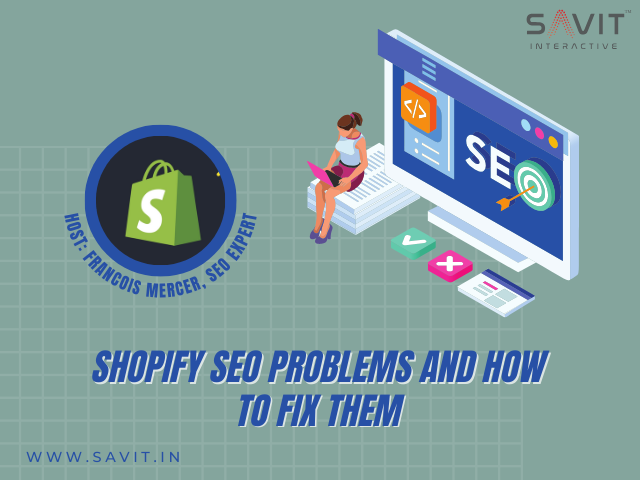Shopify is one of the best eCommerce platforms for companies to build and run their online stores. It has emerged as the go-to platform for companies wishing to swiftly and simply put up an online store owing to its robust features, broad customization choices, and user-friendly design. However, Shopify has its share of Shopify SEO issues that might affect a website’s search engine rankings, just like any other e-commerce platform. There are differences in the complexity of these issues.
This blog will examine some of the most prevalent Shopify SEO issues and provide solutions to outrank competitor websites.
What is Shopify SEO & why is it essential for business?
It can be challenging to take significant action if you are new to online selling. The practice of optimizing your store to rank high for relevant keywords in the SERPs is a phenomenon of Shopify SEO Services. This implies more sales and revenue can be generated by acquiring more organic traffic to your store. In simple terms, Shopify SEO optimizes your content to make it appear relevant to search engine queries linked to your products. It is the simplest strategy to increase traffic to your online store.
Here’s why Shopify SEO Services is important for your business:
Increased traffic: A higher-ranking shop attracts more visitors, representing more possible sales.
Free advertising: On the streets of search engines, SEO is similar to receiving free billboards! Unlike sponsored ads, clicks are free of charge.
Targeted clients: By utilizing relevant keywords, you draw in clients who are already considering your offerings, which raises the likelihood of making sales.
Increased brand awareness: Consumers looking for related products may visit your store more frequently, increasing the familiarity and recall of your brand.
Simply put, Shopify SEO increases traffic and sales to your online store by helping it get discovered by the right customers automatically and at no cost.
It’s similar to creating your storefront enticing on that crowded street! What’s the best thing, then? You don’t have to be an IT expert to get started with Shopify because it comes with built-in tools to help you optimize your store for SEO.
Is Shopify Good for SEO?
Although Shopify has shown its worth to businesses worldwide, it still has SEO problems. Since websites with higher rankings show up more prominently on search engine result webpages (SERP), search engine optimization is vital for the success of online retailers.
Similar to how SEO is a challenge for Squarespace and BigCommerce, Shopify might also need some help. They run on a closed platform that is difficult for the typical Internet user to alter. The reason for this is that consumers are unable to easily access the website’s back end and modify it to improve its SEO worth. For example, sitemaps are created automatically and are not editable, and mandated URL structures are hard to change.
Below are a few typical Shopify SEO problems in more detail to better understand the concept.
Shopify SEO Problems and Solutions
If Shopify SEO is not correctly maintained, it can occasionally become a cause of trouble for businesses. To ensure the long-term success of your website, it is critical to comprehend the possible Shopify SEO issues. Make a checklist of Shopify SEO issues that could arise to solve them instantly and be ahead in the game.
Listed below are some of the Shopify SEO issues and solutions:
Title Tag Issues
For eCommerce websites, title tags are essential since they frequently dictate whether or not a visitor will click on the website. In addition to being attention-grabbing, meta titles should be optimized for search engines by using pertinent keywords that potential buyers might use. Shopify only permits 70 characters in the title tag. Therefore, store owners who wish to include as many keywords as possible may find it difficult.
Issue: Owing to the restricted area, it is not advised to use the maximum character limit because it may impact how the website shows up in search engine results. The look of the website may suffer if retailers go overboard and use more characters than allowed.
How to resolve problems with Shopify title tags
Using the page’s bottom preview function is one way to solve the problem. This enables store managers to select the best headline that conveys important information about the product without being overly wordy and observe how the title will seem to customers. In this manner, they may maintain their title tags’ visual attractiveness while optimizing them for search engine optimization.
Shopify SEO Limitations for Meta Description
A meta description informs visitors of the page’s content before they open your website. Google typically uses the width of a pixel to calculate how much text should appear in meta descriptions. Shopify uses character limits, nevertheless, to specify how long the metadata can be.
Issue: When you have a desired page meta description in mind, but it ends up being too long, the character restriction can be a severe issue. Although the text editing procedure isn’t problematic, the minor issue gets progressively more bothersome.
How to resolve problems with Meta description limitations:
There is an easy fix for this problem. All you must do is be cautious while creating meta descriptions; choose your keywords carefully and maintain tabs on the character count. Google will index your page and display the product information in search results as soon as you publish it, along with a page meta description. Your website’s chances of appearing on the first page of search results increase with how well the meta description speaks to the needs of your prospective customers.
Restricted URL Structure
Lack of complete URL customization is one of the main issues store owners have with Shopify SEO. Shopify’s default URL structure is not always the best option for search engine optimization, as it employs parameters and query strings that can make it challenging for search engines to grasp the structure of your website. Your website may receive worse rankings and less visibility as a result of this.
Additionally, Shopify has a restricted URL structure, in contrast to other systems like WordPress or Magento. This implies that it is not feasible to arrange items and categories logically in a hierarchical structure in the same manner.
Issue: The URL must include /collections/ for all product categories and /products/ for individual goods. The main problem with this is the relatively flat structure that Shopify creates, as it only permits one subdirectory for each of the page categories.
For example, a Shopify clothing business can make the following pages for each category:
- sitename.com/collections/clothing
- sitename.com/collections/women
- sitename.com/collections/accessories
- sitename.com/collections/shirts
- sitename.com/collections/women-pants
- sitename.com/collections/women-tops
- sitename.com/collections/women-pink-tops
However, a Woo-WP website can arrange the same pages hierarchically:
- sitename.com/clothing
- sitename.com/clothing/women
- sitename.com/clothing/women/shirts
- sitename.com/clothing/women/plants
- sitename.com/clothing/women/tops/pink
- sitename.com/clothing/women/accessories
How to fix the restricted Shopify URL structure problem
Although it is not possible to modify the Shopify URL structure, internal linking can be used to tell Google about the relationships between collection pages. You can do this by putting one of the following strategies into practice:
- A mega menu that brings together similar categories can benefit your website.
- Incorporate targeted anchor text internal links to relevant collections in the descriptions of your top-level collection pages. For instance, women’s t-shirts, women’s pants and women’s shoes should all be mentioned on the Women’s clothing page. Include links to the relevant collection sites inside the text.
- To indicate to Google which sites are subcategories of each other, use breadcrumbs in conjunction with schema markup.
Canonical URLs for Shopify Online Store
The HTML components that comprise the element link are made up of canonical URLs. A canonical URL makes it possible for Google (and the other search engines) to properly index and organize the page. Duplicate versions of the same material are sent to Google if there is a problem with the canonical URL, which could be detrimental to SEO.
For example, the product URLs below are all somewhat similar. Thus, Google was unable to identify which was the most relevant.
- shoes.com
- www.shoes.com
- https://m.shoes.com
- https://amp.shoes.com
- https://shoes.com?ref=twitter
Issue: Problems with canonical URLs pertain to the same pages that are available via several URLs. Despite having a redirection tool, Shopify won’t work correctly if the website you are attempting to utilize it for already exists. In addition, people unfamiliar with SEO may find it challenging to choose the best strategy for achieving their desired outcomes.
How to fix issues related to Canonical URLs:
The good news is that not too much work is involved in solving this issue. It only requires a minor alteration to your Shopify theme file. The issue can be resolved in the following manner:
- Select Online Store => Shopify Themes from the column on the left sidebar.
- Locate the Actions button, then select Edit Code.
- In the Snippets folder, Locate “product-grid-item. liquid” and click on it
- Change this default code: <ahref=”{{ product.url | within: current collection }}” class=”product-grid-item”>
- Replace with following code: <ahref=”{{ product.url }}” class=”product-grid-item”>
After making this code modification, you can be certain that any links linked to the product pages will now use the correct URL path.
Sitemap Problems
XML sitemaps are essential to Shopify SEO as they make it possible for search engines to crawl and index the pages on your website quickly. The good thing is that you won’t have to worry about starting from scratch because Shopify automatically creates an XML sitemap whenever a new page is added. It’s crucial to remember that not every page on your website will be indexed if you don’t upload a sitemap to Google or other search engines. This is particularly true for new Shopify businesses where Google hasn’t yet completely crawled and indexed your website.
A few typical problems with Shopify sitemaps:
- No updated sitemap: If you alter your website by adding or deleting pages, you must make the necessary updates to your sitemap. Search engines can overlook new sites entirely or crawl out-of-date pages if your sitemap isn’t updated.
- Sitemap errors: Your sitemap file might have mistakes, like broken links or missing pages. These mistakes may result in search engines indexing your website entirely or ignoring certain portions.
How to resolve sitemap issues in Shopify
Establishing an XML sitemap and registering for a Google Webmaster account are essential actions to increase the visibility of your website in search engines. By doing this, Google will index any updated and new pages on your website based on a crawl of your site. The actions listed below can help you raise your chances of receiving the pages you have indexed:
- Enter the Google Webmaster Console and log in.
- Choose your website’s URL.
- Select Sitemaps after clicking the Crawl link in the Webmaster Tools Console menu.
- Click on Add/Test sitemap in the upper right corner.
- At this stage, try entering sitemap.xml.
- Send the sitemap to Google by submitting it.
These pointers conclude the matter. It may take many days for your pages to be indexed, but it will happen eventually. If you don’t notice results immediately, don’t be discouraged.
Duplicated Content
One of the most common Shopify SEO issues that can harm your store’s search engine rating is duplicate content. It becomes challenging for search engines to decide which page on your website should rank better in search results when there are numerous pages with identical information. Lower visibility and traffic to your store may be the outcome of this.
Issue: One of the most frequent issues that Shopify users run into is having their content categorized as a product or collection. When a certain product is added to a collection, it instantly creates another URL inside of it, which is quite annoying. Shopify uses the collection URL rather than the product URL as the canonical one for internal links, even when the product already has one. This may lead to duplicate content problems and severe challenges in indexing the correct pages.
How to resolve the duplicate content issue in Shopify
Here are a few solutions to resolve these issues:
- Implement Canonical Tags: These HTML elements introduce the original version of a page to search engines. You may prevent duplicate content problems by utilizing canonical tags to tell search engines which page is the main source of the material.
- Eliminate Duplicate Pages: You should think about getting rid of any pages that are identical on your website. By doing this, you may lower the possibility of duplicate content problems and raise the search engine rating of your store.
Image Alt Text
Search engines are still unable to adequately describe an image based just on its pixel count, even with its rapid progress. For this reason, adding product image descriptions to your Shopify store is crucial since it facilitates search engine optimization, which raises your site’s position.
Issue: Adding text to the “alt” attribute should be easy when adding any image to Shopify. There are, however, some exceptions: some photos are included in custom elements like sidebars and sliders in your Shopify store, or they are integrated into your theme files. Online business owners have numerous issues with these page elements since it is impossible to simply add a description.
How to resolve issues related to Image Alt Text
- Click on the “Online Store” option.
- From the sidebar on the left, choose Themes.
- Press the Actions button to make changes to the code.
- Locate the HTML <img> element with the “alt” attribute.
- Write the description of the image in “alt” text.
- Save the file.
Keep in mind that you don’t want your descriptions to appear spammy. Therefore, it’s preferable to explain the image and fill in the description field with your primary keyword at least once. Search engines will have an easier time finding your website if keywords are used frequently in the description of your photographs.
Conclusion:
Even if Shopify is a strong and well-liked platform for eCommerce companies, there are still certain Shopify SEO problems that might affect your website’s visibility and search engine ranking. You can, however, get beyond these restrictions and enhance your website’s functionality and search engine ranking by using the techniques listed in this blog. You can optimize your Shopify store for SEO success and draw more clients and visitors to your online business with a bit of work and attention to detail.
Savit Can Address Any Shopify SEO Issues You May Have
If you are looking for guidance from experienced SEO company in India, our team of SEO experts at Savit can help and guide you through Shopify’s key features and e-commerce SEO. These elements will impact your company. Not only are we informed and proficient in SEO, but we also specialize in assisting brands in reaching a wider audience through Shopify adjustments. You may focus on your strengths by letting our team help with Shopify website building and SEO problems. Get in touch with us right now, and we will be pleased to provide you with a thorough evaluation.



